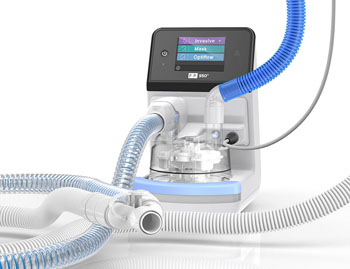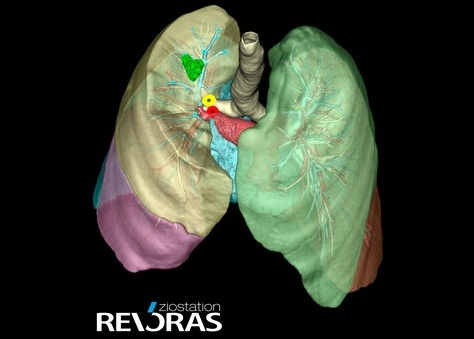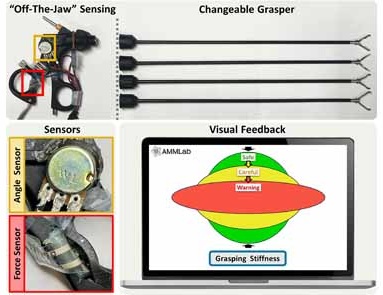New Humidification System Provides Improved Respiratory Support
|
By HospiMedica International staff writers Posted on 15 Sep 2016 |

Image: The F&P 950 humidification system (Photo courtesy of Fisher & Paykel Healthcare).
A high performance humidification system minimizes condensation and helps provide optimal breathing for patients.
The Fisher & Paykel Healthcare (F&P; Auckland, New Zealand) F&P 950 humidification system is designed to provide respiratory support across the care continuum of invasive, non-invasive, and Optiflow nasal high flow therapies, with a breathing circuit that remains closed and free of clinician intervention. The system consists of a heated humidifier base and an auto-fill chamber, with a touch screen intuitive user interface, integrated probes with novel sensing technologies, the breathing circuit itself, and a consumable sets.
The breathing circuit incorporates patented Evaqua technology, which minimizes mobile condensation in the expiratory limb by allowing water vapor to diffuse through the tubing wall before it can condense into liquid water within the circuit limb or within the ventilator. The result is an easy-to-use system that delivers optimal humidity (37° C, 44mg/L) to the breathing circuits, which use spiral wire technology for consistent compliance and low resistance in order to inimize the work of breathing.
“The F&P 950 system is the result of many years’ development work and we are pleased to be introducing this revolutionary new product to the market,” said Lewis Gradon, managing director and CEO of F&P Healthcare. “It is an outstanding addition to our range of products and we expect to see positive uptake in hospitals around the world.”
Active respiratory gas humidification ensures that patients on mechanical ventilation are supplied with optimally conditioned gases, with a minimal water content of 33 mg/dm³ and a maximum respiratory gas temperature of about 42° C. Adding water to respiratory gas is intended to minimize pulmonary infections and lung tissue damage, which is particularly problematic in patient populations with highly sensitive respiratory tracts (such as asthmatics), or among those requiring ventilation for longer periods of time.
Related Links:
Fisher & Paykel Healthcare
The Fisher & Paykel Healthcare (F&P; Auckland, New Zealand) F&P 950 humidification system is designed to provide respiratory support across the care continuum of invasive, non-invasive, and Optiflow nasal high flow therapies, with a breathing circuit that remains closed and free of clinician intervention. The system consists of a heated humidifier base and an auto-fill chamber, with a touch screen intuitive user interface, integrated probes with novel sensing technologies, the breathing circuit itself, and a consumable sets.
The breathing circuit incorporates patented Evaqua technology, which minimizes mobile condensation in the expiratory limb by allowing water vapor to diffuse through the tubing wall before it can condense into liquid water within the circuit limb or within the ventilator. The result is an easy-to-use system that delivers optimal humidity (37° C, 44mg/L) to the breathing circuits, which use spiral wire technology for consistent compliance and low resistance in order to inimize the work of breathing.
“The F&P 950 system is the result of many years’ development work and we are pleased to be introducing this revolutionary new product to the market,” said Lewis Gradon, managing director and CEO of F&P Healthcare. “It is an outstanding addition to our range of products and we expect to see positive uptake in hospitals around the world.”
Active respiratory gas humidification ensures that patients on mechanical ventilation are supplied with optimally conditioned gases, with a minimal water content of 33 mg/dm³ and a maximum respiratory gas temperature of about 42° C. Adding water to respiratory gas is intended to minimize pulmonary infections and lung tissue damage, which is particularly problematic in patient populations with highly sensitive respiratory tracts (such as asthmatics), or among those requiring ventilation for longer periods of time.
Related Links:
Fisher & Paykel Healthcare
Latest Critical Care News
- First-Of-Its-Kind AI-Powered Probability Scoring System Assesses Heart Failure with Preserved Ejection Fraction
- AI-Assisted Colonoscopy Detects More Polyps but Has Modest Effect on Cancer Risk
- Wearables Could Reduce Need for Continuous Blood Thinners in Patients with Atrial Fibrillation
- AI Model Provides Real-Time Sepsis Risk Alerts for Improving ICU Patient Survival
- AI Algorithm Improves Intravenous Nutrition for Premature Babies
- Smart Mirror Generates AI-Powered Health Insights by Analyzing Facial Blood Flow
- Painless Diabetes Patch to Replace Needle Pricks

- Sensory T-Shirt Monitors Patient’s Vitals After Urological Surgery for Cancer
- Super-Sensitive Radar Technology Warns of Serious Heart Issues
- Thermal Imaging Could Accurately Track Vital Signs for Early Disease Detection
- New Microfluidic Device Improves Safety of Leukemia Treatment for Children
- Precision Transfusion Approach Improves Outcomes in TBI Patients
- Predictive Model for Daily Risk Alerts in Sepsis Patients Enables Early Intervention
- Novel Technology Measures Intracranial Pressure More Accurately and Non-Invasively
- Novel Coating Significantly Extends Longevity of Implantable Biosensors
- Nanogel-Based Drug Delivery Technology to Improve UTI Treatment
Channels
Artificial Intelligence
view channel
Innovative Risk Score Predicts Heart Attack or Stroke in Kidney Transplant Candidates
Heart researchers have utilized an innovative risk assessment score to accurately predict whether patients being evaluated for kidney transplants are at risk for future major cardiac events, such as a... Read more
AI Algorithm Detects Early-Stage Metabolic-Associated Steatotic Liver Disease Using EHRs
Liver disease, which is treatable when detected early, often goes unnoticed until it reaches advanced stages. Metabolic-associated steatotic liver disease (MASLD), the most prevalent form of liver disease,... Read moreSurgical Techniques
view channel
Tiny Robotic Tools Powered by Magnetic Fields to Enable Minimally Invasive Brain Surgery
Over the past few decades, there has been a significant surge in the development of robotic tools designed to facilitate minimally invasive surgeries, improving recovery times and patient outcomes.... Read more
Magnetic Tweezers Make Robotic Surgery Safer and More Precise
Microrobots are small-scale robots designed using nanotechnology, and they hold significant potential for various medical applications, including surgery, targeted drug delivery, and biopsy.... Read morePatient Care
view channel
Portable Biosensor Platform to Reduce Hospital-Acquired Infections
Approximately 4 million patients in the European Union acquire healthcare-associated infections (HAIs) or nosocomial infections each year, with around 37,000 deaths directly resulting from these infections,... Read moreFirst-Of-Its-Kind Portable Germicidal Light Technology Disinfects High-Touch Clinical Surfaces in Seconds
Reducing healthcare-acquired infections (HAIs) remains a pressing issue within global healthcare systems. In the United States alone, 1.7 million patients contract HAIs annually, leading to approximately... Read more
Surgical Capacity Optimization Solution Helps Hospitals Boost OR Utilization
An innovative solution has the capability to transform surgical capacity utilization by targeting the root cause of surgical block time inefficiencies. Fujitsu Limited’s (Tokyo, Japan) Surgical Capacity... Read more
Game-Changing Innovation in Surgical Instrument Sterilization Significantly Improves OR Throughput
A groundbreaking innovation enables hospitals to significantly improve instrument processing time and throughput in operating rooms (ORs) and sterile processing departments. Turbett Surgical, Inc.... Read moreHealth IT
view channel
Printable Molecule-Selective Nanoparticles Enable Mass Production of Wearable Biosensors
The future of medicine is likely to focus on the personalization of healthcare—understanding exactly what an individual requires and delivering the appropriate combination of nutrients, metabolites, and... Read more
Smartwatches Could Detect Congestive Heart Failure
Diagnosing congestive heart failure (CHF) typically requires expensive and time-consuming imaging techniques like echocardiography, also known as cardiac ultrasound. Previously, detecting CHF by analyzing... Read morePoint of Care
view channel
Handheld, Sound-Based Diagnostic System Delivers Bedside Blood Test Results in An Hour
Patients who go to a doctor for a blood test often have to contend with a needle and syringe, followed by a long wait—sometimes hours or even days—for lab results. Scientists have been working hard to... Read more
Smartphone-Enabled, Paper-Based Quantitative Diagnostic Platform Transforms POC Testing
Point-of-care diagnostics are crucial for public health, offering rapid, on-site testing that enables prompt diagnosis and treatment. This is especially valuable in remote or underserved regions where... Read moreBusiness
view channel
Expanded Collaboration to Transform OR Technology Through AI and Automation
The expansion of an existing collaboration between three leading companies aims to develop artificial intelligence (AI)-driven solutions for smart operating rooms with sophisticated monitoring and automation.... Read more

















